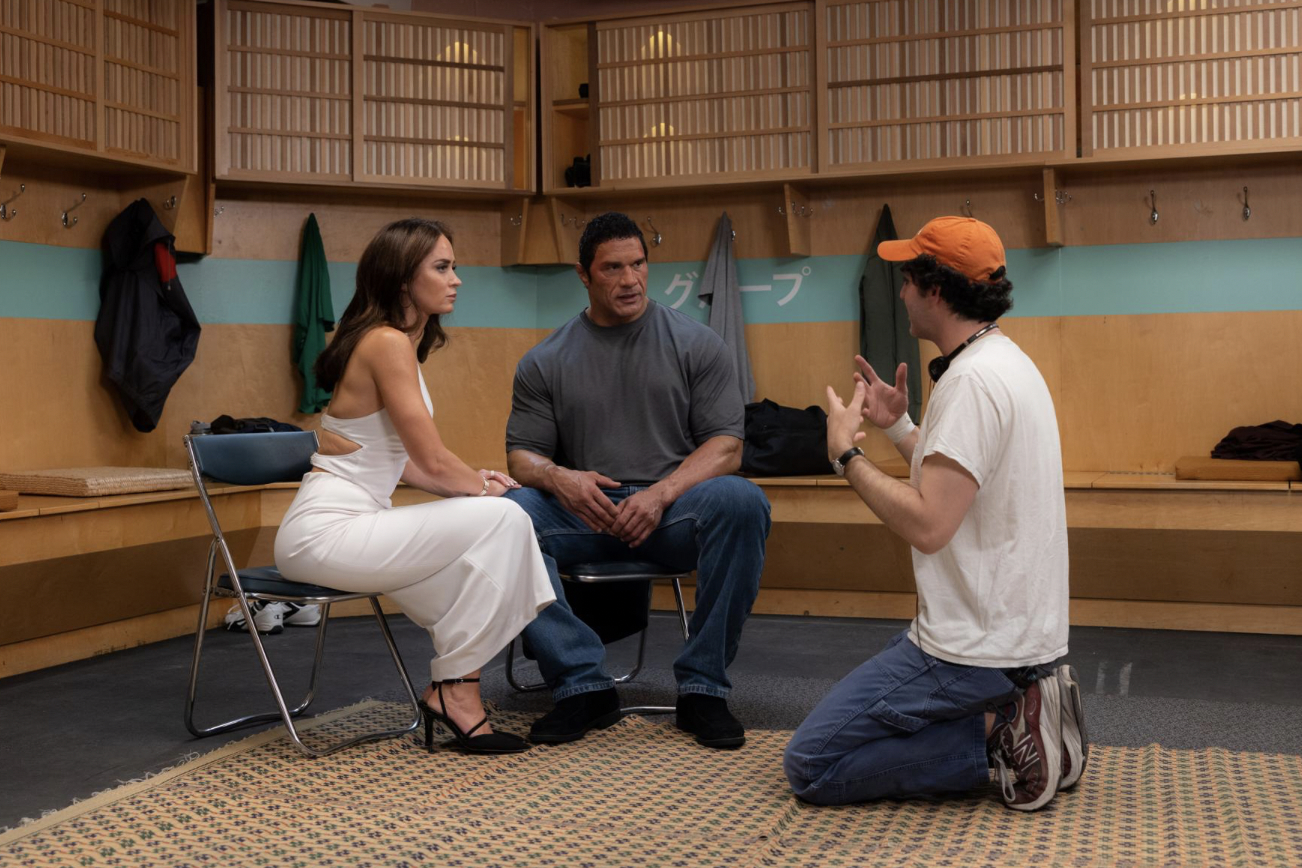Emily Blunt Steals ‘The Smashing Machine’
Blunt upstages the Rock in Benny Safdie’s new film about love and loss.

Big man. Pained soul. Mad wife. At its bleeding, opioid-addicted heart, American filmmaker Benny Safdie’s solo directorial debut, The Smashing Machine, is a film about a superhuman and his girl, struggling with the daily consequences of a life ravaged by pain and drug addiction. But despite the film’s title, The Smashing Machine is more a character study filled with tragedy and redemption than the heart-pounding cage fight audiences might expect.
Safdie, who previously co-directed Uncut Gems and Good Time with his older brother Josh, tries his very best here to elicit a sincere portrait of the American mixed-martial-arts fighter Mark Kerr, a real-life pioneer of the sport. Kerr, played by Dwayne “The Rock” Johnson, oscillates from tenderness to rage amid five-course meals of protein shakes and methadone as his lithe, cover-girl beau Dawn Staples, played by the phenomenal Emily Blunt, ebbs and flows with the every wish of his rollicking emotional landscape.
When Staples makes Kerr a protein smoothie with skim milk early in the film, Kerr awkwardly smiles and gently but sternly reminds her that he has suddenly changed to whole milk before dumping the shake down the sink. This one interaction serves as a metaphor for their chaotic relationship: buoyant and loving on the surface but deeply conflicted as both attempt to navigate the Wild West days of early MMA.
Kerr is constantly in pain. So much so that at one point he asks his doctor to swap pills for liquid medicine so he can inject it straight into his massive arms for quicker, easier relief. In one particularly illuminating moment of The Smashing Machine, Kerr turns to his trainer and grins through broken teeth. “A day without pain is like a day without sunshine,” Kerr says. The real pain of this film is in its struggle to find pace and meaning behind a wall of chaos. Where Safdie wants to take The Smashing Machine is never fully realized. It feels, at multiple points, as if it’s stretching toward grandeur without knowing exactly how to get there.
In terms of engineering, Safdie has all the important pieces fit together quite snugly. The film looks fantastic, seamlessly switching between VHS, 16mm, and 65mm formats, creating a variance in grain that works wonders to mimic the tonal quality of early MMA broadcasts. The soundtrack is wonderful as well, particularly the use of Bruce Springsteen’s “Jungleland” and a previously unreleased version of “My Way” performed by Elvis in the 1970s. The experimental jazz musician Nala Sinephro fills in the gaps with whizzing synthesizers, floating woodwinds, and dripping bass hums. Sinephro’s free-wheeling space jazz is the single finest element of the fight scenes, which play as an afterthought in a film that desires above all else to tell the story of a relationship on the brink.
But although Safdie has all the ingredients in order, the final dish tastes rather bland. The Rock, who backed the project with his own money, delivers a transformative performance throughout—the People’s Champ has become a serious actor. But his quiet, brooding Kerr never really finds the sort of emotional latency necessary to drive such an introspective study in being. Is he the best he’s ever been in The Smashing Machine? Certainly. For his performance in the moody sports biopic, the Rock received a 15-minute standing ovation at this year’s Venice Film Festival during which the former WWE wrestler let down his guard and cried tears of joy. But is the performance Oscar-worthy, as the buzz would suggest? No. In fact, the actual acting performance that grips and rips from the screen is Blunt as Kerr’s neurotic, bodacious wife-to-be.
Blunt is magnetic in The Smashing Machine. She coolly sways from a supportive, loving girlfriend to a manic-depressive lunatic who threatens suicide during Kerr’s deepest depression. Through it all, there isn’t one scene where Blunt is present that she doesn’t steal the show. Her exotic, electric aura is palpable. It ripples off the frame. Never has a woman loved her man so, nor can I remember an actress who looked more beautiful than Blunt does as Staples. Though much has been made of the Rock’s desire to compete for the Best Actor award at next year’s Oscars, it is Blunt who is likely to be the dark horse to win an Oscar for her sumptuous performance as the unhinged Staples.
For those interested in the sporting nature of Kerr’s career, HBO’s brilliant 2002 documentary of the same name should suffice. It seems that Safdie understood, intuitively, that much of that ground had already been covered and opted instead to direct his lens unto the hidden life of Kerr. A life of pain and loss and victory and turmoil. Though the film struggles under the weight of its own breathtaking hype, The Smashing Machine is still worth seeing if only to witness the commanding show that Blunt puts forward. Recommended with reservations.
The post Emily Blunt Steals ‘The Smashing Machine’ appeared first on The American Conservative.

